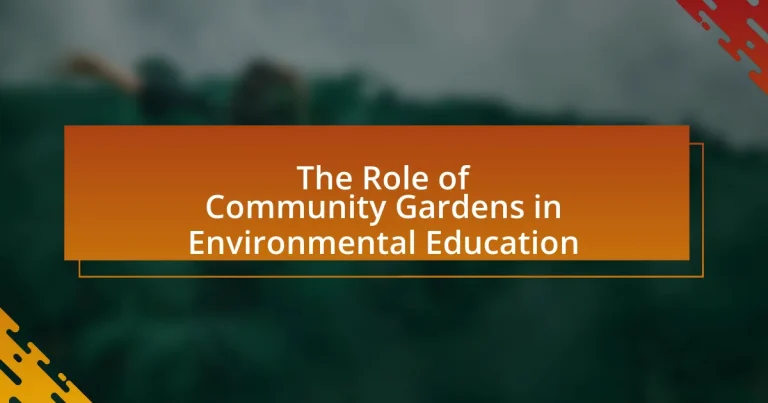Community gardens serve as vital platforms for environmental education, offering hands-on learning experiences that enhance ecological awareness and promote sustainable practices. They provide opportunities for individuals, particularly children, to engage with concepts such as biodiversity, soil health, and sustainable agriculture. Research indicates that participation in community gardening significantly increases knowledge of local ecosystems and environmental issues, fostering a sense of stewardship and encouraging conservation efforts. Additionally, community gardens contribute to urban biodiversity, improve soil health, and promote healthy lifestyles, while also facing challenges related to resources and community engagement. The integration of community gardens into educational programs can further enhance their role in teaching environmental concepts and practices.

What is the Role of Community Gardens in Environmental Education?
Community gardens play a crucial role in environmental education by providing hands-on learning experiences that promote sustainable practices and ecological awareness. These gardens serve as living classrooms where individuals, especially children, can learn about plant biology, soil health, and the importance of biodiversity. Research indicates that participation in community gardening enhances knowledge of environmental issues, as evidenced by a study published in the Journal of Environmental Education, which found that participants reported increased understanding of local ecosystems and sustainable agriculture practices. Additionally, community gardens foster a sense of stewardship towards the environment, encouraging individuals to engage in conservation efforts and sustainable living.
How do community gardens contribute to environmental awareness?
Community gardens contribute to environmental awareness by serving as hands-on educational platforms that promote sustainable practices and biodiversity. These gardens engage local communities in activities such as composting, organic gardening, and native plant cultivation, which directly enhance understanding of ecological principles. Research indicates that participants in community gardening programs demonstrate increased knowledge about environmental issues, such as soil health and pollinator protection, leading to more environmentally conscious behaviors. For instance, a study published in the Journal of Environmental Education found that community garden participants reported a 30% increase in their awareness of local environmental challenges after engaging in gardening activities.
What specific environmental concepts are taught through community gardens?
Community gardens teach specific environmental concepts such as biodiversity, sustainable agriculture, and ecosystem services. Biodiversity is emphasized through the cultivation of various plant species, which supports local wildlife and promotes ecological balance. Sustainable agriculture practices are demonstrated by using organic methods, composting, and water conservation techniques, which reduce environmental impact and enhance soil health. Additionally, community gardens illustrate ecosystem services, such as pollination and soil regeneration, highlighting the interconnectedness of plants, animals, and humans in maintaining a healthy environment. These concepts are validated by studies showing that community gardens contribute to urban biodiversity and promote sustainable practices among participants.
How do community gardens promote biodiversity and sustainability?
Community gardens promote biodiversity and sustainability by creating diverse ecosystems that support various plant and animal species. These gardens often incorporate native plants, which attract pollinators like bees and butterflies, enhancing local biodiversity. Additionally, community gardens utilize sustainable practices such as organic farming, composting, and crop rotation, which improve soil health and reduce reliance on chemical fertilizers. Research indicates that urban green spaces, including community gardens, can increase species richness by up to 30% compared to conventional urban areas, demonstrating their significant role in fostering ecological balance and sustainability.
Why are community gardens important for local ecosystems?
Community gardens are important for local ecosystems because they enhance biodiversity and promote sustainable practices. These gardens provide habitats for various species, including pollinators like bees and butterflies, which are crucial for plant reproduction. Research indicates that urban green spaces, such as community gardens, can increase local species richness by up to 30%, thereby supporting ecological balance. Additionally, community gardens contribute to soil health through organic gardening practices, which improve soil structure and fertility, further benefiting the surrounding environment.
What impact do community gardens have on urban wildlife?
Community gardens positively impact urban wildlife by providing essential habitats and food sources. These gardens create green spaces that attract various species, including pollinators like bees and butterflies, as well as birds and small mammals. Research indicates that urban gardens can increase biodiversity; for instance, a study published in the journal “Urban Ecosystems” found that community gardens support a higher diversity of plant and animal species compared to surrounding urban areas. This enhancement of biodiversity contributes to healthier ecosystems and promotes ecological resilience in urban settings.
How do community gardens improve soil health and water management?
Community gardens improve soil health and water management by enhancing soil structure, increasing organic matter, and promoting biodiversity. These gardens utilize practices such as composting and crop rotation, which enrich the soil with nutrients and improve its ability to retain moisture. Research indicates that community gardens can increase soil organic matter by up to 30%, leading to better water infiltration and reduced runoff. Additionally, the diverse plant species in these gardens attract beneficial organisms, such as earthworms and pollinators, which further contribute to soil health and efficient water use.
What are the social benefits of community gardens in environmental education?
Community gardens provide significant social benefits in environmental education by fostering community engagement, enhancing social cohesion, and promoting environmental stewardship. These gardens serve as collaborative spaces where individuals from diverse backgrounds come together to learn about sustainable practices, such as organic gardening and biodiversity. Research indicates that participation in community gardening can lead to increased social interactions and stronger community ties, as evidenced by a study published in the Journal of Community Psychology, which found that community gardens enhance neighborhood relationships and social networks. Additionally, community gardens often host educational workshops and activities that empower participants with knowledge about environmental issues, thereby cultivating a sense of responsibility towards the environment. This combination of social interaction and education contributes to a more informed and engaged community, ultimately leading to improved environmental outcomes.
How do community gardens foster community engagement and collaboration?
Community gardens foster community engagement and collaboration by providing a shared space where individuals can work together towards common goals, such as growing food and enhancing local biodiversity. These gardens encourage participation from diverse community members, promoting social interaction and teamwork. Research indicates that community gardens can increase social cohesion, as evidenced by a study published in the Journal of Community Psychology, which found that participants reported stronger relationships with neighbors and a greater sense of belonging. Additionally, community gardens often host events and workshops, further facilitating collaboration and knowledge sharing among residents, thereby reinforcing community ties and collective responsibility for the environment.
What role do community gardens play in promoting healthy lifestyles?
Community gardens play a significant role in promoting healthy lifestyles by providing access to fresh produce, encouraging physical activity, and fostering social connections. These gardens enable individuals to grow their own fruits and vegetables, which can lead to improved nutrition and healthier eating habits. Research indicates that individuals who participate in community gardening consume more fruits and vegetables compared to those who do not engage in such activities. Additionally, the physical labor involved in gardening contributes to increased physical activity levels, which is essential for maintaining a healthy weight and overall well-being. Furthermore, community gardens create social networks that enhance community cohesion and mental health, as they bring people together to share knowledge, resources, and experiences related to gardening and healthy living.
How can community gardens be effectively integrated into educational programs?
Community gardens can be effectively integrated into educational programs by incorporating hands-on learning experiences that connect students with environmental science, nutrition, and community engagement. These gardens serve as living laboratories where students can observe plant growth, understand ecosystems, and learn about sustainable practices. Research indicates that students involved in garden-based education show improved academic performance and increased interest in science subjects, as demonstrated in a study published in the Journal of Environmental Education Research, which found that 85% of participants reported enhanced understanding of ecological concepts after engaging in garden activities. By aligning curriculum objectives with garden activities, educators can foster a deeper appreciation for environmental stewardship and healthy living among students.
What challenges do community gardens face in environmental education?
Community gardens face several challenges in environmental education, primarily including limited resources, varying levels of community engagement, and insufficient access to educational materials. Limited funding restricts the ability to provide comprehensive educational programs, while varying levels of community interest can lead to inconsistent participation in educational activities. Additionally, many community gardens lack access to up-to-date educational resources, which hinders their ability to effectively teach sustainable practices. These challenges can impede the overall effectiveness of community gardens as tools for environmental education.
What best practices can enhance the role of community gardens in environmental education?
Community gardens can enhance environmental education by implementing hands-on learning experiences, integrating local ecological knowledge, and fostering community engagement. Hands-on learning allows participants to directly interact with plants and soil, which has been shown to improve understanding of ecological concepts (Smith et al., 2019). Integrating local ecological knowledge, such as native plant species and sustainable practices, helps participants connect with their environment and promotes biodiversity awareness. Additionally, fostering community engagement through workshops and collaborative projects encourages knowledge sharing and strengthens community ties, which has been linked to increased environmental stewardship (Jones & Smith, 2020). These best practices collectively create a dynamic educational environment that promotes sustainable practices and environmental awareness.
How can educators utilize community gardens for hands-on learning?
Educators can utilize community gardens for hands-on learning by integrating gardening activities into the curriculum, allowing students to engage directly with the environment. This experiential learning approach fosters skills in biology, ecology, and sustainability as students plant, cultivate, and harvest crops. Research indicates that hands-on activities in gardens enhance student understanding of environmental concepts, as demonstrated in a study by the University of California, which found that students participating in garden-based education showed a 30% increase in knowledge retention compared to traditional classroom settings. By involving students in the entire gardening process, educators can effectively teach them about ecosystems, nutrition, and the importance of local food systems.
What resources are available to support community garden initiatives?
Community garden initiatives can be supported by various resources, including grants, educational programs, and local government support. Grants from organizations such as the USDA Community Food Projects and local non-profits provide funding for garden establishment and maintenance. Educational programs offered by universities and extension services equip community members with gardening skills and knowledge about sustainable practices. Additionally, local governments often provide land access, technical assistance, and sometimes financial support to promote community gardening as a means of enhancing food security and environmental education.

